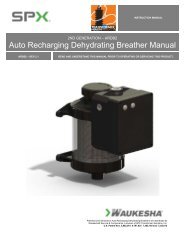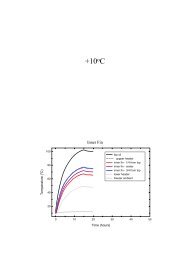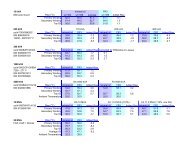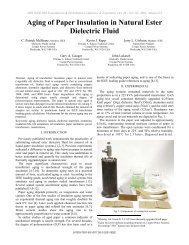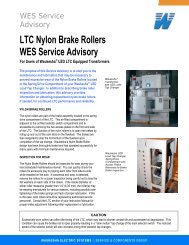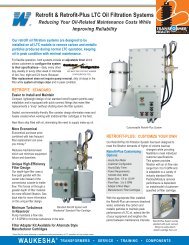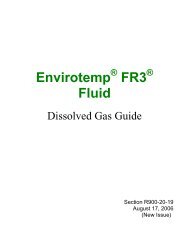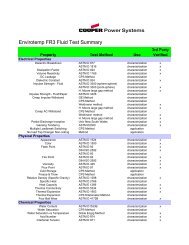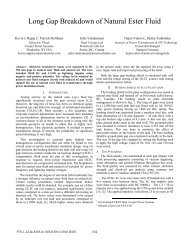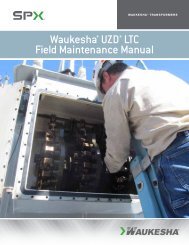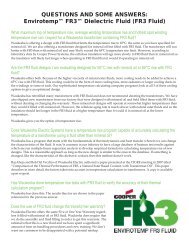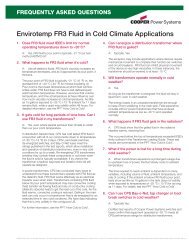Certified test report - SPX Transformer Solutions
Certified test report - SPX Transformer Solutions
Certified test report - SPX Transformer Solutions
You also want an ePaper? Increase the reach of your titles
YUMPU automatically turns print PDFs into web optimized ePapers that Google loves.
E No.: File Ref: 900<br />
CP No.: CP0502 Page 1 of 7<br />
CERTIFIED TEST<br />
REPORT<br />
COOPER POWER SYSTEMS<br />
OXIDATION STABILITY OF ENVIROTEMP ® FR3 FLUID AS<br />
MEASURED BY POWER FACTOR VALUED OXIDATION<br />
DATE: January 20, 2005 © Cooper Power Systems, Inc.
E No: File Ref: 900<br />
CP No.: CP0502 Page 2 of 7<br />
CERTIFICATION<br />
Statements made and data shown are, to the best of our knowledge and belief, correct and<br />
within the usual limits of commercial <strong>test</strong>ing practice.<br />
The information contained in this document is the property of Cooper Industries, Inc. It is not<br />
for public disclosure. Possession of the information does not convey any right to loan, sell or<br />
disclose the information. Unauthorized reproduction or use of the information is prohibited.<br />
___________________________________<br />
Kevin Rapp<br />
Project Engineer<br />
____________________________<br />
Peter Stenborg<br />
Sr. Product Specialist
E No: File Ref: 900<br />
CP No.: CP0502 Page 3 of 7<br />
Table of Contents<br />
1. Scope......................................................................................................................4<br />
2. Experimental ...........................................................................................................4<br />
3. Results & Discussion ..............................................................................................5<br />
4. Conclusions.............................................................................................................6<br />
Appendix A..............................................................................................................7<br />
References..............................................................................................................7
E No: File Ref: 900<br />
CP No.: CP0502 Page 4 of 7<br />
1. Scope<br />
An electrical insulating fluid in a transformer must have adequate oxidation stability to<br />
efficiently cool and maintain desirable electrical characteristics for the life of the transformer.<br />
The by-products of mineral oil oxidation can precipitate as sludge, can coat surfaces and<br />
eventually reduce a transformer’s cooling capacity and electrical characteristic. Oxidation<br />
inhibitor additives help postpone the degrading effects of mineral oil oxidation. Sludge formed<br />
in the oil during accelerated thermal aging is an indicator of poor stability, while the oil power<br />
factor has been established as one reliable measure of a fluid’s electrical characteristic.<br />
Doble Engineering (Boston, USA) developed the Power Factor Valued Oxidation (PFVO)<br />
and Sludge Free Life (SFL) <strong>test</strong>s as indicators of the oxidation stability of transformer oil<br />
during accelerated life <strong>test</strong>ing [1]. The PFVO <strong>test</strong> measures the presence and behavior of<br />
contaminants that are both inherent in a fluid and are produced during oxidation. The SFL<br />
<strong>test</strong> detects sludge that can be formed as by-products of oxidation. Both <strong>test</strong>s are part of the<br />
Doble <strong>Transformer</strong> Oil Purchase Specification (TOPS). The PFVO and SFL <strong>test</strong> results<br />
provide useful information that can be applied to natural esters in a more realistic operating<br />
environment than many of the ASTM methods 1 . The PFVO and SFL <strong>test</strong>s were performed on<br />
Envirotemp ® FR3 fluid and other natural and synthetic ester fluids that are composed of<br />
different base fluids and additives to determine comparative oxidation stability.<br />
2. Experimental<br />
The SFL and PFVO <strong>test</strong>ing was performed by the Doble Engineering Company per the<br />
referenced Doble methods [2]. The sludge free life is determined by withdrawing periodic<br />
samples that are monitored for evidence of sludge formation. The PFVO <strong>test</strong> consists of<br />
power factor measurements of a fluid during a required 140 hours of fluid oxidation at 95°C<br />
with a copper catalyst and an air atmosphere. Two different samples of the natural ester<br />
Envirotemp FR3 fluid, another high oleic natural ester identified as “Competitor A” and a<br />
synthetic polyol ester identified as Envirotemp 200 fluid were <strong>test</strong>ed.<br />
1 See Appendix A
E No: File Ref: 900<br />
CP No.: CP0502 Page 5 of 7<br />
3. Results & Discussion<br />
Sludge Free Life Test: The results of SFL <strong>test</strong>ing showed that all four ester samples<br />
maintained sludge free life throughout the required 88 hours <strong>test</strong> duration.<br />
Power Factor Valued Oxidation: The results of the PFVO <strong>test</strong>ing are shown below in the<br />
comparative plot of fluid power factors at 95°C versus oxidation time in hours. Both<br />
Envirotemp FR3 fluid samples were well within the TOPS limit of 4.5% power factor.<br />
Envirotemp 200 fluid and “Competitor A” samples exceeded the TOPS limit prior to the 140<br />
hour <strong>test</strong> duration.<br />
PFVO of Natural and Synthetic Ester Fluids<br />
% Power Factor at 95 o C<br />
12<br />
10<br />
8<br />
6<br />
4<br />
2<br />
Envirotemp FR3 Fluid (Sample #1)<br />
Envirotemp FR3 Fluid (Sample #2)<br />
"Competitor A" High Oleic Ester<br />
E-200 Synthetic Polyol Ester Fluid<br />
PFVO Limit<br />
0<br />
0 20 40 60 80 100 120 140<br />
Oxidation Time (hours)
E No: File Ref: 900<br />
CP No.: CP0502 Page 6 of 7<br />
4. Conclusions<br />
The SFL <strong>test</strong> results show that several types of ester fluids meet the 88 hour sludge-free<br />
life requirement of the Doble TOPS, which was developed for conventional mineral oils.<br />
The PFVO results showed different results for the three types of ester fluids <strong>test</strong>ed:<br />
• The “Competitor A” high oleic natural ester fluid, <strong>report</strong>ed to be able to pass the<br />
ASTM D2440 oxidation stability <strong>test</strong>, actually had the least favorable outcome. It<br />
exceeded the Doble limit of 4.5% power factor before 80 hours.<br />
• The synthetic ester, Envirotemp 200 fluid, exceeds the 4.5% Doble limit at 110 hours.<br />
• The natural ester, Envirotemp FR3 fluid, performed the best. The power factor of both<br />
samples stayed below 2% over the required 140 hour time period.<br />
The results of the SFL and PFVO <strong>test</strong>s, together with full scale accelerated aging per<br />
IEEE C57.100 [3], analysis of free-breathing transformers and data from in-service<br />
transformers of sealed design demonstrates that the natural ester, Envirotemp FR3 fluid,<br />
maintains excellent stability for application in transformers of sealed design and limited<br />
concern for transformers that may occasionally become free-breathing [4].<br />
The changes seen in Envirotemp FR3 fluid in free-breathing transformers over the course<br />
of eight years confirm that while Envirotemp FR3 fluid may not be suitable for application in<br />
free-breathing designed transformers: 1) the dissipation factor and neutralization number will<br />
provide ample forewarning of atmospheric leaks, and 2) air leaks occurring over extended<br />
periods of time, measured in years, will not cause fluid degradation sufficient to adversely<br />
affect transformer operation.
E No: File Ref: 900<br />
CP No.: CP0502 Page 7 of 7<br />
Appendix A:<br />
The ASTM <strong>test</strong> methods D2440 and D2112 [5,6] developed to evaluate, in a short period<br />
of <strong>test</strong> time, the relative effectiveness of anti-oxidation additives in conventional mineral oil.<br />
An all too common misapplication of the ASTM <strong>test</strong>s is to predict, based on the results, a<br />
given fluid’s stability in actual transformer service. Another growing error is the application of<br />
the ASTM methods to fluid types other than mineral oil, including natural vegetable oil based<br />
ester dielectric fluids, such as Envirotemp ® FR3 fluid. The methods accomplish this by<br />
prescribing the use of ample pure oxygen and copper catalyst at temperatures up to 140°C.<br />
These ASTM accelerating <strong>test</strong> conditions are too severe for ester fluids and lead to<br />
polymerization with no useful information derived during the process, because they do not<br />
relate to any actual situation within a transformer in service.<br />
Envirotemp FR3 fluid oxidizes differently than mineral oil and does not form sludge<br />
precipitates. Instead, the fluid will slowly become more viscous, but will maintain the<br />
important functional properties. The ASTM <strong>test</strong>s used to assess mineral oil lot-to-lot variability<br />
and effectiveness of oxidation inhibitor content are not applicable to ester-based fluids. The<br />
ASTM D2440 and D2112 <strong>test</strong> methods are intended only to evaluate antioxidant additives in<br />
mineral oil. The <strong>test</strong>s use conditions unrelated to transformer operation.<br />
<strong>Transformer</strong>s of sealed design protect internal components from exposure to oxygen and<br />
atmospheric moisture. In the event that a transformer does develop a leak above the fluid<br />
level, insulating fluid of any type is subject to some gradual oxidation from air at the<br />
headspace interface. An on-going study being conducted on free-breathing FR3 fluid filled<br />
transformers showed that the fluid viscosity increased a modest 8.6% after seven years of<br />
operation [4]. Significant antioxidant additive depletion is evident, as is the expected oxidation<br />
of the natural ester. However, the transformers are still operating normally and pass IEEE<br />
C57.100 electrical stress <strong>test</strong>s at regular intervals.<br />
References<br />
[1] Oliver, F.S., “Doble Power-Factor Valued Oxidation Tests,” Doble Conference Minutes<br />
1960, Insulating Fluids/ 10-401, pgs 1-9<br />
[2] Instructions for Doble Oil Comparator 12E-I-871, Doble Engineering Company, pgs 1-23<br />
[3] C.P. McShane, G.A. Gauger, J. Luksich, “Fire Resistant Natural Ester Dielectric Fluid<br />
and Novel Insulation System for Its Use”, IEEE/PES T&T Conference, Apr. 12-16, 1999,<br />
IEEE 0-7803-7287-5/01/ IEEE T&D, © 2001<br />
[4] Cooper Power Systems Dielectric Fluids Products Engineering Report DFR2004-1213,<br />
‘Field Analysis of Envirotemp FR3 Fluid in Sealed versus Free-Breathing <strong>Transformer</strong>s,<br />
December 13, 2004<br />
[5] “Standard Test Method for Oxidation Stability of Inhibited Mineral Oil by Pressure<br />
Vessel,” ASTM D2112-01a, ASTM International, West Conshohocken, PA<br />
[6] “Standard Test Method for Oxidation Stability of Mineral Insulating Oil,” ASTM D2440-99,<br />
ASTM International, West Conshohocken, PA




